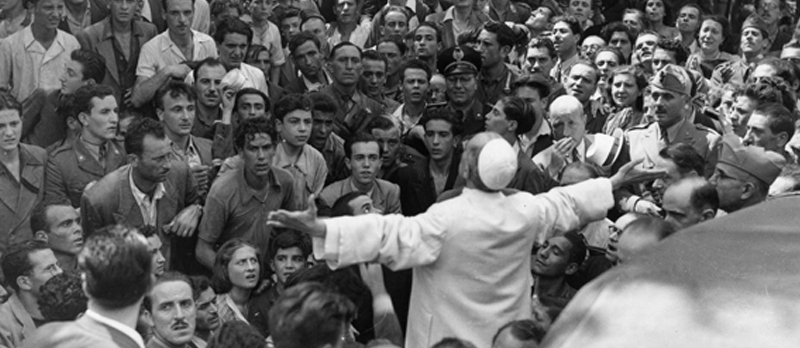An interview with Professor Pierluigi Guiducci, author of several works on the pontificate of Pope Pius XII during the Second World War.
“Comitato Papa Pacelli – Associazione Pio XII”, an organization for the beatification of Pope Pius XII, led by Roman Rota attorney Emilio Artiglieri, held a symposium on June 4th to commemorate the great work of charity of the World War II-era pontiff in favor of the eternal city. That date marked the 75th anniversary of the liberation of Rome by Allied troops. What the Venerable Pope Pius XII did in those dramatic circumstances to spare Rome from destruction earned him the title of Defensor Civitatis (Defender of the City).
Professor Pier Luigi Guiducci was a keynote speaker of the event, which was presided over by Cardinal Dominique Mamberti, the Prefect of the Supreme Tribunal of the Apostolic Signature.
Guiducci teaches History of the Church at the Pontifical Lateran University. His many books include Il Terzo Reich contro Pio XII – Papa Pacelli nei documenti nazisti (The Third Reich against Pius XII: Pope Pacelli in Nazi documents [2014]) and Oltre la leggenda nera – Il Vaticano e la fuga dei criminali nazisti (Beyond the Black Legend: The Vatican and the Flee of the Nazi Criminals [2015]), in which he refuted accusations and innuendos that Pius XII was a supporter of the Hitler regime.
Professor Guiducci spoke with CWR about his research and writings about Pius XII.
CWR: How did Pius XII manage to prevent Rome from being damaged or destroyed during the most devastating horrors of the war?
Guiducci: In the Second World War Pius XII, after having tried in vain to make Italy remain neutral, sought to maintain continuous contacts with the warring parties through the Nunciatures and the diplomatic representations inside the Vatican and in Rome, including those of neutral countries. This action, inconspicuous but persistent, attempted to circumscribe as much as possible death and suffering … among civilians.
Moreover, through his own trustees and humanitarian organizations, he wanted to keep every possible channel of communication open with both sides in the Italian territory itself. This was indispensable for accessing camps for prisoners (who were also from other countries), to mitigate court sentences, to prevent military actions capable of causing further deaths, to support the distribution of food and clothing inside and outside Rome, to receive displaced persons, to support the elderly, the sick, the disabled, pregnant women, minors, to give news to families who were divided by the war.
In addition to these many initiatives, the Pope also addressed the problem of the safety of Rome. This orientation was not an act of preference but a realistic step. The City, in addition to its religious and historical value, was the capital of a country at war against the Anglo-Americans (and their Allies) and therefore particularly serious risks were looming over the “Urbe” (viz. the city of Rome).
CWR: Why was it not possible to avoid some tragedies, such as the allied bombing of San Lorenzo and other neighborhoods?
Guiducci: Unlike the cautious U.S. position, Churchill’s line was openly in favor of bombing Rome, due to the presence of Italian planes in the final phase of the “battle of England”.
Rome was struck for the first time on July 19, 1943. Pilots failed in most cases to hit targets. Densely populated areas and hospitals were destroyed. San Lorenzo was the district mostly damaged, together with Tiburtino, Prenestino, Casilino, Labicano, Tuscolano and Nomentano. The bombs caused 3,000 deaths and 11,000 injuries. On July 20, Pius XII sent a letter of protest to the U.S. president [Franklin D. Roosevelt].
The raids continued on August 13th. Among the dead was Father Raffaele Melis, a parish priest who rushed to offer religious comforts to seriously injured people. The bombardments continued even in the following days. In this context, the Pacelli’s visit to the destroyed districts (the San Lorenzo area Outside the Walls, Appio Latino, Porta Maggiore and Casilino areas) in order to assist the survivors is difficult to forget. According to most historians it was in these hours that the person of Pacelli looked particularly tried.
Despite the fact that the Pontiff was faced with an incessant number of tragedies ever more extensive, he continued to issue assistance directives, as evidenced by the testimonies of his most direct collaborators.
CWR: And what was happening on the German side?
Guiducci: With the German occupation of a part of the Italian territory, more and more serious events were taking place in the diocese of Rome, such as the house-to-house search for the Jews in Rome (October 16, 1943) and their deportation (more than a thousand people of all ages).
Some alerted the Jews of the imminent danger but the alarm was neglected by those responsible for the community. Others (the Allies) did not reveal that they had known of the upcoming drama for several days (having been able to decrypt the Nazi dispatches). The partisan units also lacked any military initiatives.
Despite these evidences, in later times all attention was focused only on Pius XII, who was accused of “passivity”. However, in recent years, several authors—including myself—have published more documents that attest to the activation of a network of contacts to stop the Nazi operation in Rome and to try to save the persecuted. In particular, there is still silence on the connections between the Pope’s nephew Carlo Pacelli, Father Pancrazio Pfeiffer and General Rainer Stahel, and on contacts between Stahel and Heinrich Himmler.
Following this articulated action, Berlin ordered the roundup to be stopped. It should be added that some authors continue to not include in the number of Jews rescued those who managed to hide before October 16 because they were informed by many Catholics (including police officers), and those who managed to escape capture on the very October 16, nor those who after October 16th were protected by ecclesial institutions and by Catholic sectors.
The Holy See’s decision to circulate to the Roman religious institutions a letter to be presented in case of German raids, immediately after October 16, 1943, has to be seen against this background.
The text read that the specific Institution was a section working for the Sacred Congregation of the Religious, at the service to the Holy See, and as such could not be subject to search or requisition without prior agreement with the Ecclesiastical Superiors of the said Sacred Congregation. The certificate was issued by the Governor of the Vatican City State, “on behalf of the Most Eminent Cardinal Luigi Maglione, Secretary of State of the reigning Supreme Pontiff Pope Pius XII”. This document is the proof of the order orally given by Pacelli to protect every institution present in Rome that hid persecuted people (especially Jews).
CWR: Meanwhile the situation in Rome was getting worse and worse…
Guiducci: Yes. The confrontation between opponents and occupiers was becoming increasingly violent in the city, as shown by the March 22, 1944 attack on Via Rasella by communist partisans, in which 33 German soldiers and two civilians were killed. The German retaliation at the Cave Ardeatine caused the death of 335 people. Among these, the figure of Don Pietro Pappagallo stands out. Although he himself was a prisoner, he succeeded in giving the last blessing to the condemned. Anyhow, there are documents on the attempt by the Holy See to reach the German commands through Father Pancrazio Pfeiffer, but the religious could not speak with some military commanders because the entire operation was completed within 24 hours and because the German offices had been closed.
But Pius XII was also well aware of other dramas, not only related to hunger, such as the phenomenon of the black market and the ruthlessly suppressed popular protest demonstrations, but also concerning the wicked actions of those who profited from the sufferings of the persecuted, denounced hidden Jews (leading to 747 arrests), and collaborated in espionage actions. But the Pontiff could also hear reports on the heroism of many Catholics (some of them later declared “Righteous among the Nations”), including priests and religious.
In this context, Pacelli, with his own trustees, was able to protect those who defended the persecuted of the time in Rome. In other cases his voice remained unheeded. The papal initiatives also helped to avoid a tragedy. On the evening of June 3, 1944, the German troops began to leave Rome, while on June 4th the allied forces entered the city: the possible war inside the city had been avoided thanks also to the moderating action of Pius XII.
CWR: In light of the above, what conclusions do you draw?
Guiducci: The most recent research, such as the study of the documents of the Vatican Secret Archive and the investigations carried out by myself with reference to Nazi espionage in the Vatican, and the relationship between Pius XII and the Roman parish priests in 1943-1944, not only confirmed the humanitarian work of Pacelli (the only authority not to flee from Rome) and the presence of active networks of solidarity in Rome, but they also provided further data:
1) the de-facto isolation that the Pope had to endure from the conflicting nations (despite all appearances of the contrary);
2) the continued reprisals that undermined the peace initiatives of Pius XII., especially in Germany, Poland, Holland, and in Italy itself.
3) the Nazi blockade on every Vatican humanitarian aid in favor of internees, with some drivers of Vatican humanitarian convoys killed by bombing.
Ultimately, every historical analysis must be well-thought, especially if you are in the presence of continued unpleasant facts. An example concerns the use of sorters, tabs, and printers of the American IBM in support of the Third Reich, in use in the central offices of the Shoah and in the extermination camps. Only the U.S. entry into the war, in 1941, partially stopped this synergy. Nor can we forget the fact that, although they knew the location of the extermination camps, the Allies did not want to bombard the lines of communication to prevent convoys packed with Jews from getting there.
At this point, looking at a Pope—Pius XII—who lived in the midst of colossal tragedies, from the Holocaust to the explosion of two atomic bombs and terrible massacres with millions of civilian and military deaths, we can only take a double stance on Pope Pacelli: first of all of respect, and then of objective understanding.
Back to the news


 OTHER
OTHER